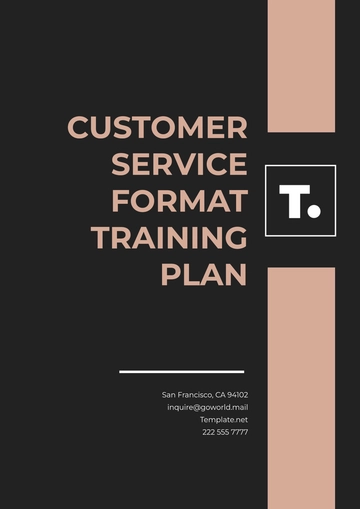Free Compliance Training Plan

Report Creator: [Your Name]
Department: [Your Department]
Company Address: [Your Company Address]
Reporting Period: [Reporting Period]
I. Introduction
We at [Your Company Name] recognize the key part played by compliance training in ensuring full compliance with related regulations, policies, and ethical standards relevant to our business sector. To underline this point and offer a pragmatic approach, we've taken the initiative to compile a thorough checklist. This detailed guide outlines the main steps required to formulate and execute an efficient compliance training program effectively.
II. General Information
Scope: This compliance training plan applies to all employees of [Your Company Name].
Frequency: Compliance training should be conducted [frequency] and may vary based on regulatory requirements and organizational needs.
Duration: The duration of each training session may vary depending on the topic and delivery method.
Training Format: Training sessions may be conducted in-person, online, or through a combination of both.
Documentation: All training activities and records should be documented and maintained for audit and compliance purposes.
III. Assess Training Needs
Identify relevant regulations, laws, and industry standards applicable to [Your Company Name].
Conduct a risk assessment to determine areas of highest compliance risk.
Survey employees to understand their current knowledge and training needs.
Review past incidents or violations to identify recurring compliance issues
IV. Define Training Objectives
Clearly define the goals and objectives of the compliance training program.
Align training objectives with regulatory requirements and organizational values.
Specify desired outcomes, such as improved awareness, behavior change, or reduced risk.
V. Develop Training Content
Create or acquire training materials tailored to [Your Company Name]’s specific compliance needs.
Ensure training content is engaging, relevant, and easy to understand.
Include real-life scenarios, case studies, and examples to enhance learning.
Incorporate interactive elements, such as quizzes or simulations, to reinforce concepts.
VI. Determine Training Methods
Choose appropriate training delivery methods based on the nature of content and audience preferences.
Options may include in-person workshops, online courses, webinars, or blended learning approaches.
Consider accessibility and accommodate diverse learning styles and needs.
VII. Establish Training Schedule
Develop a training schedule that ensures all employees receive required training within designated timeframes.
Consider scheduling options to accommodate different shifts, locations, and roles.
Provide advance notice of training sessions to allow for adequate planning and participation.
VIII. Assign Responsibility
Designate a compliance officer or training coordinator responsible for overseeing the training program.
Identify subject matter experts or trainers to facilitate training sessions.
Communicate roles and responsibilities clearly to all stakeholders involved in training delivery.
IX. Implement Training Program
Launch the compliance training program according to the established schedule.
Monitor attendance and participation to ensure all employees complete the required training.
Address any technical or logistical issues promptly to minimize disruptions.
X. Evaluate Training Effectiveness
Gather feedback from participants to assess the effectiveness of training content and delivery.
Measure learning outcomes against predefined objectives and performance indicators.
Identify areas for improvement and make necessary adjustments to the training program.
XI. Document Training Records
Maintain accurate records of employee training completion, including dates, topics, and attendance.
Store training documentation securely and in compliance with relevant data protection regulations.
Ensure records are easily accessible for audits, reporting, and verification purposes.
XII. Review and Update Training Program
Regularly review and update the compliance training program to reflect changes in regulations, policies, or organizational needs.
Seek input from stakeholders to identify emerging compliance risks or training gaps.
Continuously improve training content and delivery methods based on feedback and evaluation results.
Conclusion
A well-designed and implemented compliance training plan is essential for promoting a culture of compliance and mitigating risks for [Your Company Name]. By following this checklist, [Your Department] can ensure that employees receive the necessary knowledge and skills to fulfill their compliance obligations effectively.

[Your Name]
Compliance Officer
Date: [Insert Date]
Compliance Templates @ Template.net
- 100% Customizable, free editor
- Access 1 Million+ Templates, photo’s & graphics
- Download or share as a template
- Click and replace photos, graphics, text, backgrounds
- Resize, crop, AI write & more
- Access advanced editor
Unlock seamless compliance training with our expertly crafted Compliance Training Plan Template, offered by Template.net. Tailor-made for your business needs, this customizable template ensures effortless alignment with regulatory requirements. Downloadable and printable, it's easily accessible for immediate implementation. Editable in our AI Editor Tool, streamline your compliance procedures with precision and ease. Elevate your compliance game today
You may also like
- Finance Plan
- Construction Plan
- Sales Plan
- Development Plan
- Career Plan
- Budget Plan
- HR Plan
- Education Plan
- Transition Plan
- Work Plan
- Training Plan
- Communication Plan
- Operation Plan
- Health And Safety Plan
- Strategy Plan
- Professional Development Plan
- Advertising Plan
- Risk Management Plan
- Restaurant Plan
- School Plan
- Nursing Home Patient Care Plan
- Nursing Care Plan
- Plan Event
- Startup Plan
- Social Media Plan
- Staffing Plan
- Annual Plan
- Content Plan
- Payment Plan
- Implementation Plan
- Hotel Plan
- Workout Plan
- Accounting Plan
- Campaign Plan
- Essay Plan
- 30 60 90 Day Plan
- Research Plan
- Recruitment Plan
- 90 Day Plan
- Quarterly Plan
- Emergency Plan
- 5 Year Plan
- Gym Plan
- Personal Plan
- IT and Software Plan
- Treatment Plan
- Real Estate Plan
- Law Firm Plan
- Healthcare Plan
- Improvement Plan
- Media Plan
- 5 Year Business Plan
- Learning Plan
- Marketing Campaign Plan
- Travel Agency Plan
- Cleaning Services Plan
- Interior Design Plan
- Performance Plan
- PR Plan
- Birth Plan
- Life Plan
- SEO Plan
- Disaster Recovery Plan
- Continuity Plan
- Launch Plan
- Legal Plan
- Behavior Plan
- Performance Improvement Plan
- Salon Plan
- Security Plan
- Security Management Plan
- Employee Development Plan
- Quality Plan
- Service Improvement Plan
- Growth Plan
- Incident Response Plan
- Basketball Plan
- Emergency Action Plan
- Product Launch Plan
- Spa Plan
- Employee Training Plan
- Data Analysis Plan
- Employee Action Plan
- Territory Plan
- Audit Plan
- Classroom Plan
- Activity Plan
- Parenting Plan
- Care Plan
- Project Execution Plan
- Exercise Plan
- Internship Plan
- Software Development Plan
- Continuous Improvement Plan
- Leave Plan
- 90 Day Sales Plan
- Advertising Agency Plan
- Employee Transition Plan
- Smart Action Plan
- Workplace Safety Plan
- Behavior Change Plan
- Contingency Plan
- Continuity of Operations Plan
- Health Plan
- Quality Control Plan
- Self Plan
- Sports Development Plan
- Change Management Plan
- Ecommerce Plan
- Personal Financial Plan
- Process Improvement Plan
- 30-60-90 Day Sales Plan
- Crisis Management Plan
- Engagement Plan
- Execution Plan
- Pandemic Plan
- Quality Assurance Plan
- Service Continuity Plan
- Agile Project Plan
- Fundraising Plan
- Job Transition Plan
- Asset Maintenance Plan
- Maintenance Plan
- Software Test Plan
- Staff Training and Development Plan
- 3 Year Plan
- Brand Activation Plan
- Release Plan
- Resource Plan
- Risk Mitigation Plan
- Teacher Plan
- 30 60 90 Day Plan for New Manager
- Food Safety Plan
- Food Truck Plan
- Hiring Plan
- Quality Management Plan
- Wellness Plan
- Behavior Intervention Plan
- Bonus Plan
- Investment Plan
- Maternity Leave Plan
- Pandemic Response Plan
- Succession Planning
- Coaching Plan
- Configuration Management Plan
- Remote Work Plan
- Self Care Plan
- Teaching Plan
- 100-Day Plan
- HACCP Plan
- Student Plan
- Sustainability Plan
- 30 60 90 Day Plan for Interview
- Access Plan
- Site Specific Safety Plan





























